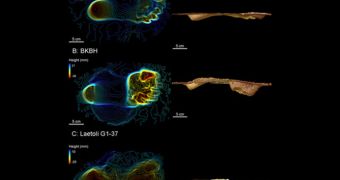Our earliest ancestors, the ancient hominids, are known for their affinity to trees. They spent much of their lives in the canopies of forests in the land that is now Tanzania, Africa, and only descended on the ground occasionally. However, when they did, they appeared to have extended their legs in very much the same way we do today. Their stride was very similar to our own, according to footprints dated to 3.6 million years ago, Wired reports.
The finding is crucially important, given that many experts believed upright walking developed gradually, and over extended periods of time. The recent discovery seems to contradict this widely-held belief, and to hint at modern strides developing in leaps and spurs, rather than in one, continuous flow. The site that yielded these conclusions is located in Laetoli, Tanzania, where a now-renowned trackway of footprints was discovered some three decades ago. At the time when the tracks were laid, the area was apparently covered by wet volcanic ash, in which two or three of our ancestors walked.
Human walking is very energy-efficient because it relies on an extended-leg type of stride, which experts believed developed later on in our evolution. However, analysis of the deep heel and toe impressions that the Laetoli hominids left behind seems to indicate that they walked in ways similar to our own today, and that they were very energy-efficient in their efforts. The findings were made by a team of experts at the University of Arizona in Tucson, led by anthropologist David Raichlen. Details of the study appear in the March 22 issue of the open-access scientific journal PLoS One.
“By the time hominids walked through the ash at Laetoli, they walked more like us than like apes,” the team leader says. Scientists have thought until recently that this stride only appeared once our species, the Homo sapiens, developed, some 2.5 million years ago. According to previous analysis of the trackway, it would appear that the markings on the ground were left behind by Australopithecus afarensis, a species of hominids which included the famous fossilized remains that we now call Lucy.
“I doubt that the case is closed on debate over what gait was like in australopithecines, but this new study has made important strides in that direction,” adds of the new work George Washington University anthropologist Brian Richmond.

 14 DAY TRIAL //
14 DAY TRIAL //